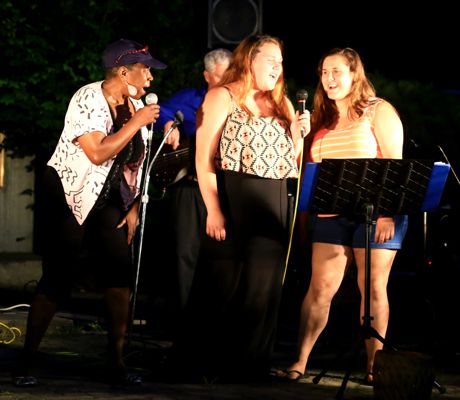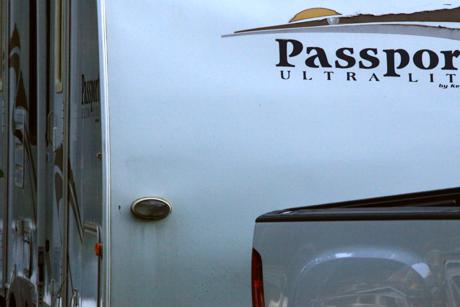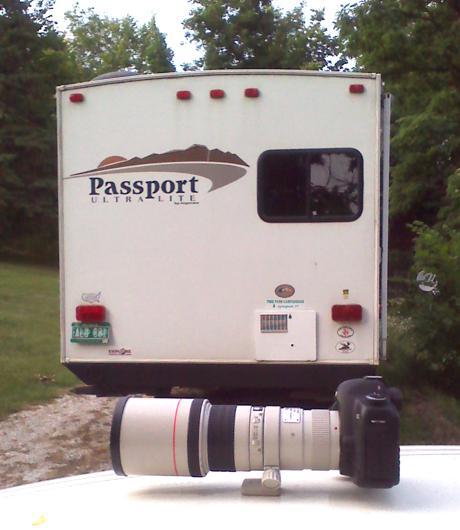
Wordless Wednesday



 I’ve been looking for a “supertelephoto” lens for a while because I want to be able to sneak up on shots like this without having to squint. I decided on a 400 mm “prime” lens — a photographic lens with a single, fixed focal length, as opposed to the often more popular zoom lens. You have to work harder with a prime lens but they are generally sharper and lighter than zooms. Here’s Canon’s description of the one that chose me:
I’ve been looking for a “supertelephoto” lens for a while because I want to be able to sneak up on shots like this without having to squint. I decided on a 400 mm “prime” lens — a photographic lens with a single, fixed focal length, as opposed to the often more popular zoom lens. You have to work harder with a prime lens but they are generally sharper and lighter than zooms. Here’s Canon’s description of the one that chose me:
Photographers can use the Canon EF 400 mm telephoto UD ultra-clear lens for total sharpness in each photo. Both a manual focus and an auto-focus help photographers get the focus they want, from artistic blurs to vivid clarity. The focus is easily adjusted with a smooth turning diaphragm in manual mode. The Canon EF 400 mm is made in a lightweight design weighing only 44 oz for easy travel and long hours of use. This telephoto camera lens is compatible with Canon EF design cameras. This Canon camera lens also features a 400 mm length for super close-up telephoto photography. A f/5.6 aperture is ideal for general photography in many different light settings. As a fixed focal length lens with a built-in hood to reduce flare, the Canon EF 400 mm lens helps photographers shoot outside at long ranges in both bright or dimly lit environments. With a two-element design, this Canon camera lens can produce sharp clear images. The telephoto camera lens is multi-coated to reduce glare, aberration, and discoloration.
It is, bar none, the best lens of its size in the world. (44 ounces, by the way, is less than three pounds which is seriously light in a world where a similar zoom lens weighs twice that.) Now I just had to wait for one to come along that I could afford.
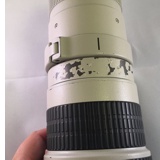 “This lens will NEVER win a beauty contest,” the seller wrote. “It has several exterior scratches and scrapes. The glass is in excellent condition. Package includes case (also has seen better days), both end caps and original box.” She even offered Free UPS Shipping, insured.
“This lens will NEVER win a beauty contest,” the seller wrote. “It has several exterior scratches and scrapes. The glass is in excellent condition. Package includes case (also has seen better days), both end caps and original box.” She even offered Free UPS Shipping, insured.
I wondered if the lens has ever been dropped? Any graunch or grind in the focus? Dust or mold?
“I have never dropped the lens. I bought the lens used, and can’t speak to its history. I’ve used it for 2 years now and have moved up to a 100-400. The focus is smooth and fast and there is no visible dust or mold on the glass.”
These are sample photos taken with a Canon EF 400mm f/5.6 L prime lens and two different camera bodies. As Ken Rockwell is fond of reminding us, L simply means “expensive as L.” I mixed it up taking the test shots, using a Canon 5DMkII and a Canon 6D. I tried both handheld and on two different tripods.
 The lens is better than I am. I was up in Canada and took this shot of the Canadian and Quebec flags on a quay in Baie Missisquoi. I was on a low tripod, shooting with a 6D and just far enough away that the tattered flags filled the frame. No cropping.
The lens is better than I am. I was up in Canada and took this shot of the Canadian and Quebec flags on a quay in Baie Missisquoi. I was on a low tripod, shooting with a 6D and just far enough away that the tattered flags filled the frame. No cropping.
That’s a salable image. I’ll contribute the profits from the first sale toward new flags for that pole.
 I panned around to a fisherman working very, very hard at his craft. I was on the low tripod, shooting with a 6D and just far enough away that the fisherman filled the frame. No cropping. I counted the hairs on his arm. I then backed away to capture the inset. (The original inset is just as sharp as the closeup, but it loses some since I resampled it for this file.)
I panned around to a fisherman working very, very hard at his craft. I was on the low tripod, shooting with a 6D and just far enough away that the fisherman filled the frame. No cropping. I counted the hairs on his arm. I then backed away to capture the inset. (The original inset is just as sharp as the closeup, but it loses some since I resampled it for this file.)
 Same thing here. Do you suppose this is an abandoned one room schoolhouse and transportation system? I was close enough to the bus and house trailer that I could have used less lens. I used the same low tripod, shooting with the 6D. I cropped the height.
Same thing here. Do you suppose this is an abandoned one room schoolhouse and transportation system? I was close enough to the bus and house trailer that I could have used less lens. I used the same low tripod, shooting with the 6D. I cropped the height.
I try always to ask permission to shoot onto private land, even if I’m shooting from a public road. That’s a salable image although the owner was pretty confused that I wanted it.
 The float and slide are off a small point 4,400 feet out and the shoreline with trees in their far background are 11-12,000 feet out from my own dock. Same part of the lake as the Canadian photos but a mile south of the border. I used the same low tripod, shooting with a 6D. I’m not sure yet if the softness is shutter tremor or heat shimmer.
The float and slide are off a small point 4,400 feet out and the shoreline with trees in their far background are 11-12,000 feet out from my own dock. Same part of the lake as the Canadian photos but a mile south of the border. I used the same low tripod, shooting with a 6D. I’m not sure yet if the softness is shutter tremor or heat shimmer.
I took this shot handheld with a 5DMkII at 7:57 p.m. EDT, 19 minutes before sunset, with ISO 1250, 1/1600 @ f/8, manual focus. The colors are real. I wanted the paddlers who were out about 10-11,000 feet from me. What I got, if you look at the ridge line and maybe biggify it a lot, are 35 of the wind turbines of Marble River Wind Farm in Altona, NY. That’s almost due west of North Puffin about 40.5 miles as the Canada Goose flies. I have never ever seen those windmills from here before.
I probably can’t sell this but it’s still a helluva pitcher!
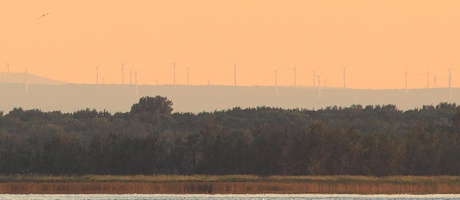
So far, I’m using the common sense tools I already knew to do. I used fast shutter speeds, a shutter release, and my new-to-me tripod. I tried it as a monopod but got a lot of motion. I locked up the mirror. This Lens doesn’t have Image Stabilization. I tightly frame as much as is possible with a prime lens. And I did use the very shallow depth of field to advantage on the closer shots.
Stuff I’ve learned so far:
It turns out that these long, heavy lenses are much steadier if you use heavy stuff as vibration dampening. One photographer suggests laying your arms, hands, and even face right on the tripod mounted lens. Others hang their gadget bags on the tripod hook to anchor them. Maybe both.
improvephotography.com notes that “Increasing the ISO also dramatically reduces the visible detail in the photo.” We all know that high ISO speeds add noise to photos although most digital cameras filter that out. I suspect those very filters also are what smoosh the details.
Ken Rockwell writes, “Unless you absolutely need depth of field, avoid apertures smaller than f/8. The resolving power of a modern digital SLR is so great that you will soften your images by stopping down unnecessarily. This is why many point-and-shoot cameras don’t stop down past f/8.” I’ll be darned. I didn’t notice a lot of softening between f/8 and f/14 but it was there.
This lens has scratches and scrapes and scruffy, scruffy paint, but the glass, the glass is in excellent shape. Looks like a winner to me. Once I get in some more practice time.

Sometimes you just can’t plan for nights like this. Another North Puffin tale.
Jazz mesmerized our North Puffin Town Park last night as we continued the 26th year of free outdoor concerts with Jenni Johnson and the Jazz Junketeers.
The forecast called for a pretty good chance of rain across Vermont last evening. That’s a bad thing for an outdoor concert.
I obsessed over the radar yesterday as I do but we got lucky: it was clear and sunny all day. The rain had gotten only as far north as Ticonderoga by 5 p.m. and was pretty well trapped between Route 2 and Route 4 (the central third of Vermont) for the later afternoon and evening. By the time the concert ended, it was still raining in southern New England but the Vermont rain had pushed across New Hampshire into Maine. I figured there was a small chance we’d get a little from the storms coming up the Adirondacks but we didn’t even get that although there is finally some light rain here as I write this.
That should be enough for a great evening but wait! There’s more!
An international entertainer, Jenni has sung jazz, blues, and funk since her own teen days in New York City. She spent the 1980s on musical projects in Houston and Boston including her own Billie Holiday Story. She launched her Jazz Junketeers in 1989 to sing the jazz and blues standards by her favorite African-American artists. Now she remains an active touring artist who has played more of our Summer Sounds concerts — and picked on me more — than any other performer.
During the first set, I spotted Verne Colburn in the audience. Verne was the longtime director of Bellows Free Academy music, an incredible Jazz pianist, and beloved in northwestern Vermont. He turned 80 in April. I popped onto the stage (we’re very informal here in North Puffin) and asked Jenni to throw a song out to him.
Jenni did what Jenni does. “Verne is in the house,” she sang and she kept doing it until he came up on stage. Turns out he and Jenni’s keyboard player, Kent Baker, are old friends, so Kent turned the keys over and Verne soloed with the band on Fly Me to the Moon.

Oh. You want more?
Last season, we started introducing the musicians who will create the future of Summer Sounds. These young performers are our opening acts or, as last night, our “middle acts.”
Jaylin Seaman took over the mic for a short set of modern songs as well as a couple of show tunes and wowed the crowd again.
“That girl is headed to Broadway,” Jenni said.
Yeppers. Jaylin plays Helen in Dream at the Spotlight Black Box Theater starting next week. Based on Shakespear’s romantic comedy, A Midsummer Night’s Dream, Dream is a magical musical retelling but set in present day Central Park, New York City. It features Broadway’s Robi Hager and members of the Vermont Musical Theater Academy.
Local community groups host our concerts with a social that usually includes munchies, grilled foods, or desserts. Last night Taylor Hall led an MVUHS group raising funds for a school trip to the presidential inauguration. They had a new table of actual food. I smartly extracted a promise that they would take no tomatoes to Washington, though.
Two of Jenni’s “Junkettes” closed the show with Jenni on Mustang Sally. The Junkettes are four of Highgate’s own young people who have grown up dancing and singing to Jenni’s performances here. Here they are in 2009.

